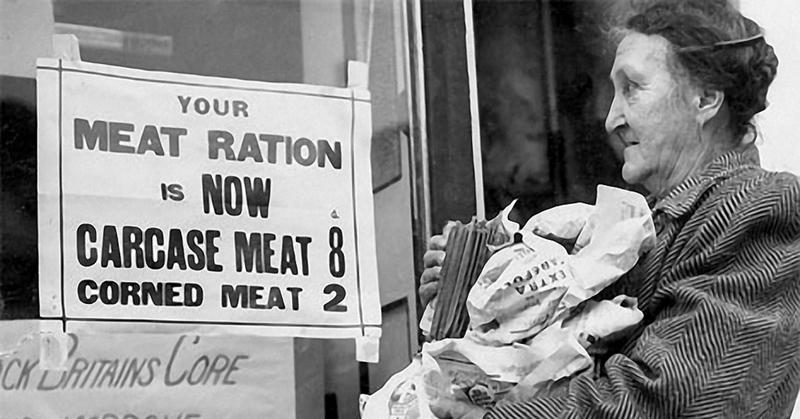1944: World War II Rationing Of Most Meat Grades Officially Ends
By | May 1, 2020

During the onslaught of World War II, Americans at home tightened their belts and sacrificed many of their favorite meals when they were asked to ration much-needed supplies like meat, butter, sugar, and milk. It was a necessity for the war effort, as soldiers couldn't fight their battles for peace in Europe and Japan without sustenance, but when it officially came to an end, people were pumped. They could finally eat a steak dinner again and not worry about neighborhood whispers if they put on a pot roast.
Fear Of Shortage
The Food Rationing Program began in early 1942, and Americans who weren't prepared saw their lives change overnight. People were already being asked to conserve gas, clothing, and food to help servicemen overseas, but the government had to step in to make sure the wealthy weren't buying up all of the most useful commodities. This fear of shortages wasn't unfounded—we've even seen it happen in times of peace. During the outbreak of COVID-19, many people couldn't find toilet paper for months.

A Tough But Simple System
Obviously, there were no computers during World War II, so complying with the nation's rationing regulations involved what we would consider an exotically analog system today. A member of each family had to register for rationing books which included removable stamps that were good for different types of items, like sugar, meat, oil, butter, etc. If you didn't have a stamp for a particular item, you couldn’t buy it. Meat, butter, and oil were all “red stamp” items, meaning that they were in the highest demand overseas. Once a family's ration stamps ran out, they weren't allowed to buy that specific food until the next ration book arrived. This strict law forced homemakers to get creative with their menus.

"Variety Meats"
Prior to rationing, anyone with enough money could eat like Ted Nugent all day. That all changed on March 29, 1943, when beef, pork, veal, lamb, tinned meats, and fish were added to the rationing list. This left Americans scrambling for whatever was readily available, leading to an increase in chicken-raising and sales of canned spam. Funded by the Department of Defense, the National Research Council attempted to convince Americans to eat cuts of meat that soldiers wouldn't, specifically organ meats. At the time, organ meats were considered peasant food, only eaten by those who hailed from rural areas or had an unsophisticated upbringing.
To convince Americans to eat organ meat, the NRC did two very smart things. First, they rebranded the unsavory cuts as "variety meats," making liver, tongue, and brains sound like a party for your mouth. Following that genius move, they suggested that Americans incorporate "variety meats" into their meals only occasionally, not every day. It took some time, but by the end of the war, organ meats were a common and acceptable staple.

Black Market Meat
Just because the government makes a rule doesn't mean that people are going to follow it. During Prohibition, bootleggers made booze, and during the coronavirus pandemic of 2020, people gathered in big, germy crowds despite CDC orders. During World War II, an underground market sprang up around the sale of meat. According to the Department of Agriculture, at least 20% of all meat sold during this time came from the black market. It wasn't anything insidious—most underground meat sales took place between a local butcher and his normal patrons. If a family used up their meat stamps but had money to burn, they could often pay a premium for their butcher to look the other way.
One of the more unsettling black market food practices during World War II, however, came in the form of unregulated slaughtering. Livestock would be purchased above the ceiling price and sold to black market distributors at a huge mark-up.

Long-Lasting Effects
Meal planning in the time of rationing and shortages was a bit of a catch-22. Much like the recent COVID-19 outbreak, when shelter-in-place orders discouraged frequent shopping trips, meals needed to carefully planned but also flexible. If the store was out of what you needed on the day you went, your whole menu might need to be altered on the fly.
These practices stayed with Americans for years following the war, out of both habit and necessity. Even though most rationing restrictions were lifted by August 1945, supplies like sugar was still in low supply until 1947. Rationing became a normal part of life for the next few years, both to conserve and to make sure families were ready in case they needed to tighten their belts once again.

